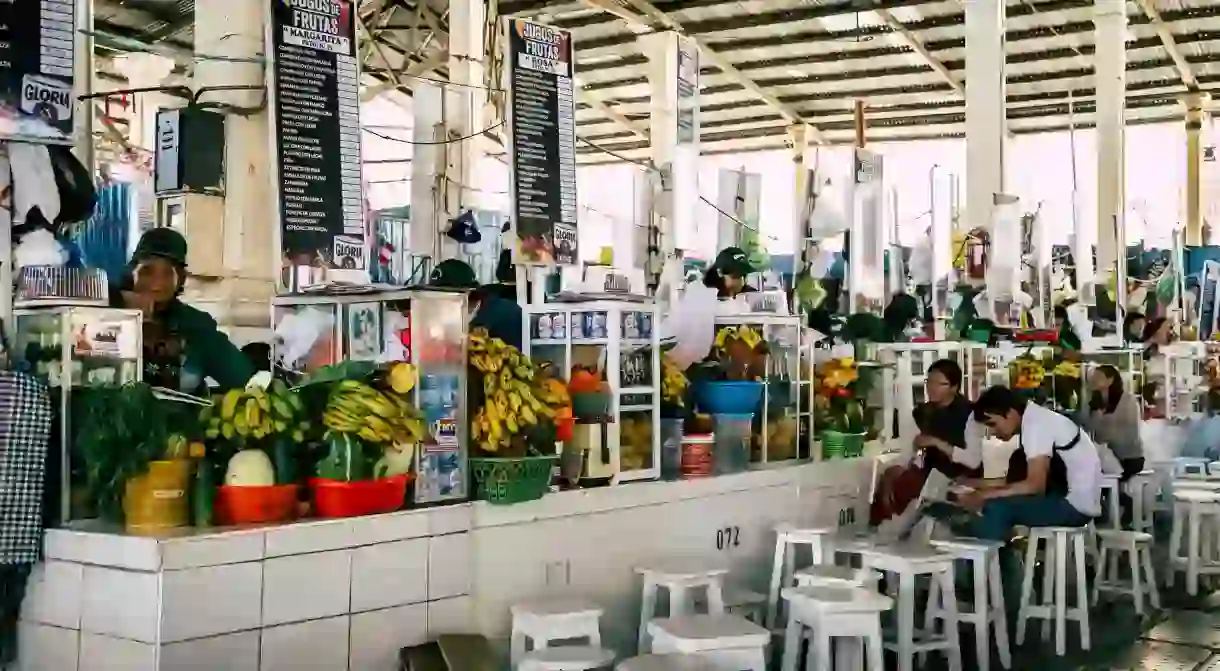A Two-Week Foodie Itinerary Through Peru

In 2013, Peruvian food won its first Michelin star in London. A few years later, ten of Lima’s eateries made it into the top 50 Restaurants of Latin America. In early 2018, Peruvian cuisine bagged its biggest prize yet: Stars of the Lima restaurant scene Central, Maido, and Astrid y Gastón featured in the World’s Top 50 list, officially turning Peru into one of the hottest new culinary destinations on the planet. From fine dining in Lima to sampling grilled grub worms in the Amazonian jungle, this two-week itinerary will have every foodie reaching for their passport.
Day 1-2: Fine dining and cevicherias in Lima
Home to some of the world’s best restaurants, Lima is at the forefront of Peru’s worldwide culinary revolution. It is here that the country’s diverse cooking techniques and flavors – ranging from tropical jungle fruits to Andean corn and quinoa – bubble together in one big, creative pot; it’s a fusion that has earned restaurants like Central and Astrid y Gastón worldwide recognition.

For the city’s top restaurants, head to swanky neighborhoods Miraflores and San Isidro and make a reservation (way in advance) for one of Lima’s famous evening tasting menus. For lunch on day two, stop by one of the city’s cevicherias, laid-back lunchtime restaurants dedicated to serving up the country’s most celebrated dish – you probably guessed it: ceviche. Cevicheria Bam Bam, La Mar Cebicheria, and Chez Wong are just some of the city’s star ceviche joints. If you want to get even more local, Lima’s markets, such as Mercado Central and Mercado de Surquillo, also serve up quality (and cheap) ceviche and other seafood dishes amidst the hustle and bustle of a typical Peruvian market.

Day 3-6: Ancient Andean cuisine in Cusco
The next stop on your culinary journey will take you from Lima’s warm Pacific to the snow-capped peaks of the Andes. Being over 3,000 metres (9,843 feet) higher than the capital, the food that grows in and around Cusco’s chilly highlands is very different to what you’ll find in the rest of the country. Fresh fish and tropical fruits are replaced by over 4,000 varieties of potatoes, corn of every size and colour, and an abundance of alpaca and cuy (guinea pig) meat.

Kickstart your arrival in Cusco with a guided culinary tour of Mercado San Pedro, where you’ll learn about the market’s huge variety of vegetables, spices and medicinal plants, as well as the important role they play in Andean cooking. TASTE Peruvian Cooking Studio (as well as Peruvian Cooking Class and Cusco Culinary) combines the market tour with a two-hour cooking class. The next day, head out to the nearby Sacred Valley or Ausangate region for a demonstration of how the Incan Pachamanca (a marinated meat and potato dish cooked under hot stones) is prepared. If you’re not too squeamish, you could also learn how to make traditional cuy al horno (roasted guinea pig) with a local family here.

Other culinary highlights in the city include cuy al horno from Pachapapa, lomo saltado (strips of steak stir-fried with vegetables and fries) from Gaston’s Chicha, and the city’s best chifa (Peruvian Chinese) at KION.
Day 7-10: Markets and picanterias in Arequipa
Once you’ve got your fill of guinea pig and potatoes, it’s time to head south for a whole new foodie experience. Arequipa – or the “white city” as its affectionately known thanks to the white volcanic stone used in most of its architecture – is renowned for having its own thing going on when it comes to food. It was here that the famous rocoto relleno (stuffed rocoto pepper), chupe de camaron (Prawn soup), and Sunday adobo were created. Today, the same recipes are still used by abuelas (grandmothers) behind wood-fired stoves in the city’s famous picanterías, (no-frills, hole-in-the-wall restaurants serving Peru’s tastiest (and biggest) set menus). The city’s bustling central market, too, is filled with an impressive variety of fresh fruits, vegetables, cheese, meats and a whole host of fancy superfoods that are worth a try.

Spend a few days here hunting down the best lunchtime picanterias (La Lucila, La Nueva Palomino and La Capitana are must-visits), as well as sampling the city’s best local produce at San Camilo Market. If you’re looking for Arequipa’s more up-market local restaurants, treat yourself to a meal at Chicha, La Tradicion Arequipeña or Zig Zag. If you didn’t get a chance to take a cooking class in Cusco or Lima, Arequipa is also a great place to take one. The Peruvian Cooking Experience and Peruvian Flavour come highly recommended.
Day 11-14: Amazonian delights in Iquitos

Your final stop takes you to jungle foodie haven, Iquitos – and it might just be your biggest foodie challenge yet. Cut off from the outside world (and maybe too adventurous for many), Amazonian food has stayed out of the international limelight. However, fresh river fish, barbecued meats, fiery charapita ají (chili pepper) marinades and tropical fruit juices make this place a must-stop for adventurous travelers. The best place to sample some of the region’s most famous delicacies – such as fried leafcutter ants, grilled grub worms, jungle meat parrilladas (barbecues) and juanes (rice with meat or fish steamed in plantain leaves) – is at traditional jungle market, Mercado Belén. From here, it’s just a two-hour flight back to Lima. If you time it right, there might just be time for a last-minute bowl of ceviche before your flight home.













